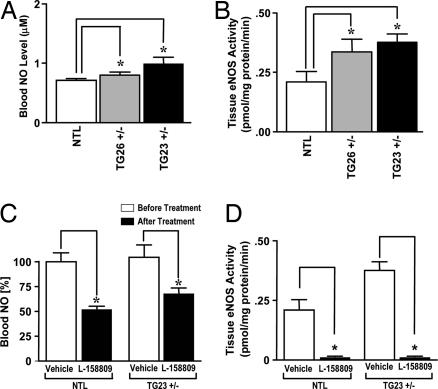Fig. 4.
Mechanism of elevated NO in the Tie1-AT1R TG mice. (A) Blood NO level in 4-month-old NTL, TG26+/−, and TG23+/− mice (n = 10; ∗, P < 0.05). (B) NOS activity measured in the aortic homogenates from NTL, TG26+/−, and TG23+/− mice (n = 10; ∗, P < 0.05). Citrulline formation from arginine was determined in the presence (total NOS) and absence inducible NOS (iNOS) of free Ca2+; eNOS activity was calculated by subtracting iNOS from total activity for each individual animal. (C) Ability of L-158809 (0.025 mg/ml in drinking water) to rescue TG23+/− mice from the “elevated NO” phenotype after a 4-week treatment. The blood NO level was significantly reduced in both NTL and TG23+/− mice (n = 10; ∗, P < 0.05). (D) Suppression of eNOS activity in the aortic homogenates after 4-week treatment with L-158809 (0.025 mg/ml in drinking water) (n = 10; ∗, P < 0.05).

